UGB 262: Quality Management Strategy for Engineering Tooling Company
VerifiedAdded on 2022/12/05
|12
|4085
|139
Report
AI Summary
This report provides a comprehensive analysis of quality management strategies for the Engineering Tooling Company (ETC). It begins with an introduction to the company and its challenges, particularly in light of globalization and increased competition. The main body delves into a strategic plan for quality improvement, emphasizing Total Quality Management (TQM) principles, including customer focus, continuous improvement, and employee involvement. The report explores the significance of quality assurance and quality control measures, such as inspections, adherence to ISO 9000 standards, and the implementation of quality manuals. It also discusses the importance of sustaining a culture of quality within ETC, addressing stakeholder satisfaction and the role of leadership in driving quality initiatives. The report concludes with recommendations for ETC, including a focus on innovation, customer experience, and cost reduction, along with strategies for long-term sustainability. The overall aim is to help ETC enhance its competitiveness and achieve organizational excellence.
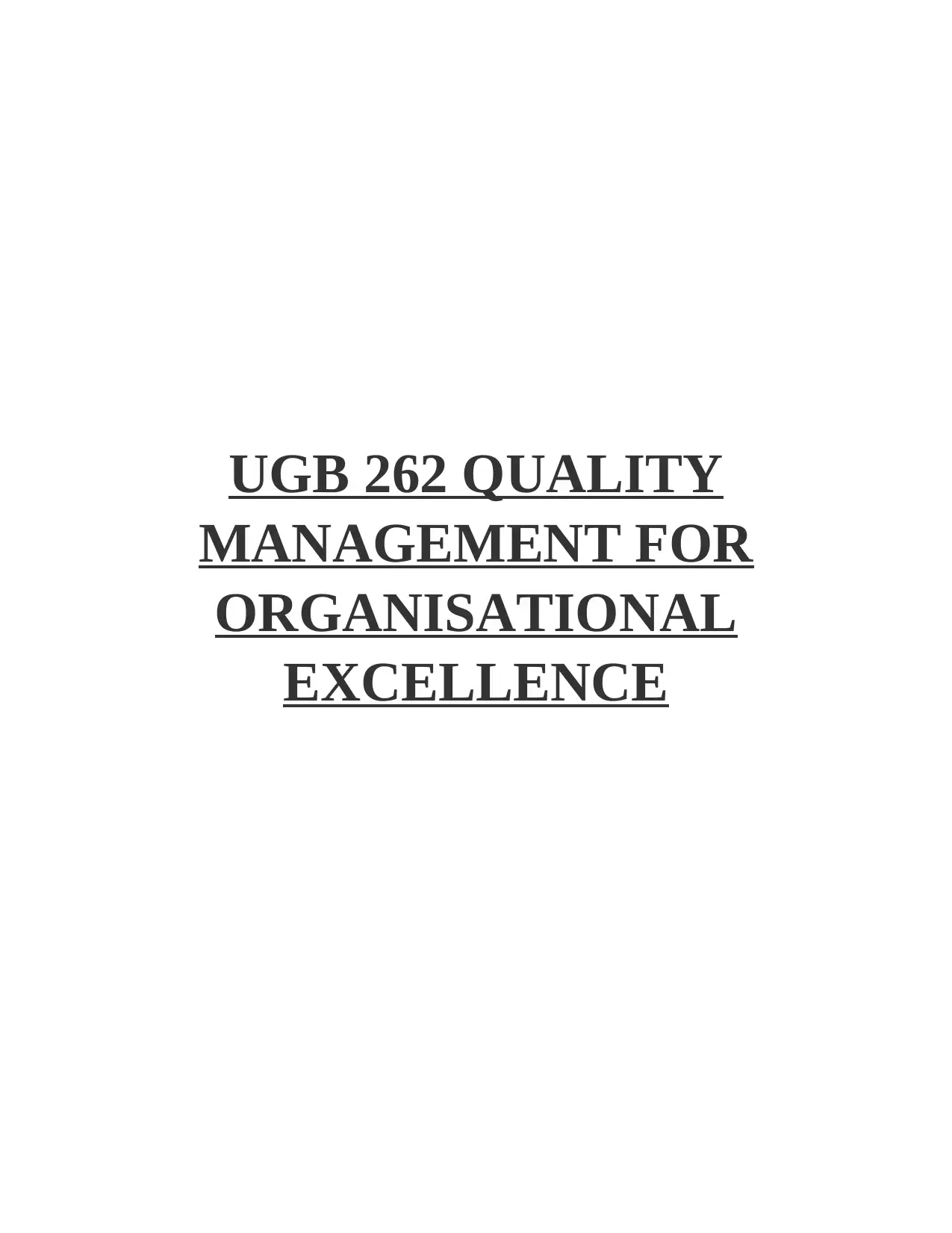
UGB 262 QUALITY
MANAGEMENT FOR
ORGANISATIONAL
EXCELLENCE
MANAGEMENT FOR
ORGANISATIONAL
EXCELLENCE
Paraphrase This Document
Need a fresh take? Get an instant paraphrase of this document with our AI Paraphraser
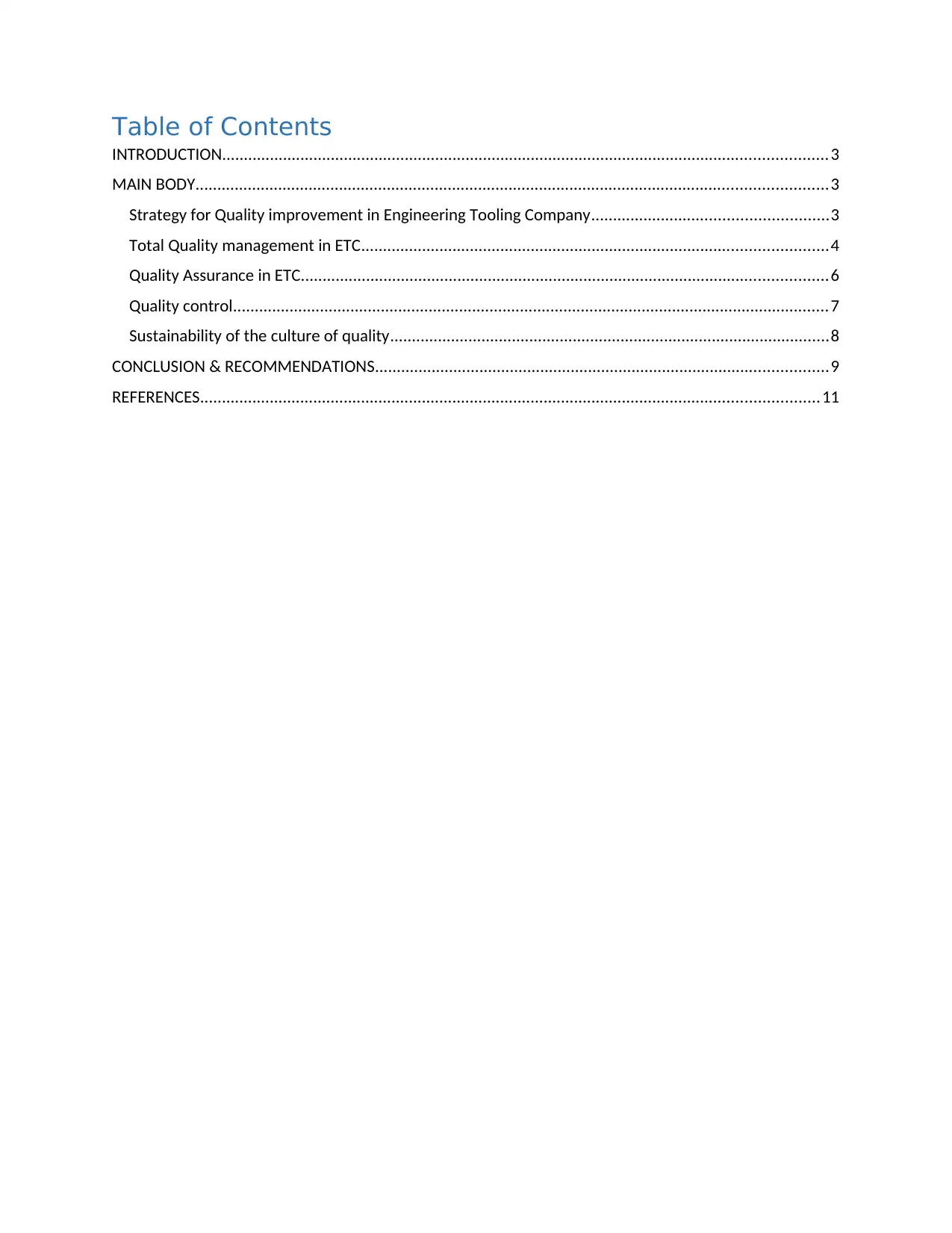
Table of Contents
INTRODUCTION...........................................................................................................................................3
MAIN BODY.................................................................................................................................................3
Strategy for Quality improvement in Engineering Tooling Company......................................................3
Total Quality management in ETC...........................................................................................................4
Quality Assurance in ETC.........................................................................................................................6
Quality control.........................................................................................................................................7
Sustainability of the culture of quality.....................................................................................................8
CONCLUSION & RECOMMENDATIONS........................................................................................................9
REFERENCES..............................................................................................................................................11
INTRODUCTION...........................................................................................................................................3
MAIN BODY.................................................................................................................................................3
Strategy for Quality improvement in Engineering Tooling Company......................................................3
Total Quality management in ETC...........................................................................................................4
Quality Assurance in ETC.........................................................................................................................6
Quality control.........................................................................................................................................7
Sustainability of the culture of quality.....................................................................................................8
CONCLUSION & RECOMMENDATIONS........................................................................................................9
REFERENCES..............................................................................................................................................11
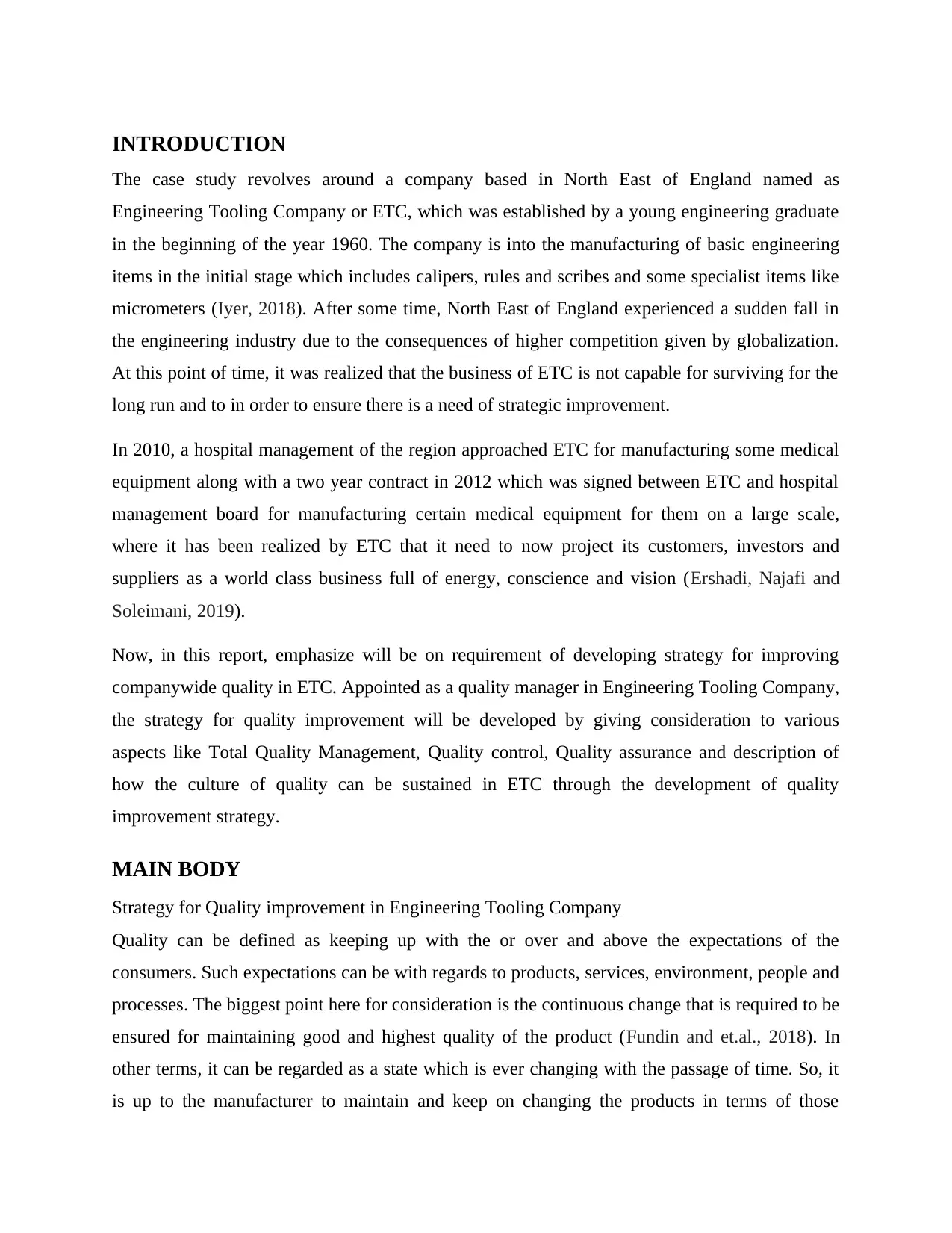
INTRODUCTION
The case study revolves around a company based in North East of England named as
Engineering Tooling Company or ETC, which was established by a young engineering graduate
in the beginning of the year 1960. The company is into the manufacturing of basic engineering
items in the initial stage which includes calipers, rules and scribes and some specialist items like
micrometers (Iyer, 2018). After some time, North East of England experienced a sudden fall in
the engineering industry due to the consequences of higher competition given by globalization.
At this point of time, it was realized that the business of ETC is not capable for surviving for the
long run and to in order to ensure there is a need of strategic improvement.
In 2010, a hospital management of the region approached ETC for manufacturing some medical
equipment along with a two year contract in 2012 which was signed between ETC and hospital
management board for manufacturing certain medical equipment for them on a large scale,
where it has been realized by ETC that it need to now project its customers, investors and
suppliers as a world class business full of energy, conscience and vision (Ershadi, Najafi and
Soleimani, 2019).
Now, in this report, emphasize will be on requirement of developing strategy for improving
companywide quality in ETC. Appointed as a quality manager in Engineering Tooling Company,
the strategy for quality improvement will be developed by giving consideration to various
aspects like Total Quality Management, Quality control, Quality assurance and description of
how the culture of quality can be sustained in ETC through the development of quality
improvement strategy.
MAIN BODY
Strategy for Quality improvement in Engineering Tooling Company
Quality can be defined as keeping up with the or over and above the expectations of the
consumers. Such expectations can be with regards to products, services, environment, people and
processes. The biggest point here for consideration is the continuous change that is required to be
ensured for maintaining good and highest quality of the product (Fundin and et.al., 2018). In
other terms, it can be regarded as a state which is ever changing with the passage of time. So, it
is up to the manufacturer to maintain and keep on changing the products in terms of those
The case study revolves around a company based in North East of England named as
Engineering Tooling Company or ETC, which was established by a young engineering graduate
in the beginning of the year 1960. The company is into the manufacturing of basic engineering
items in the initial stage which includes calipers, rules and scribes and some specialist items like
micrometers (Iyer, 2018). After some time, North East of England experienced a sudden fall in
the engineering industry due to the consequences of higher competition given by globalization.
At this point of time, it was realized that the business of ETC is not capable for surviving for the
long run and to in order to ensure there is a need of strategic improvement.
In 2010, a hospital management of the region approached ETC for manufacturing some medical
equipment along with a two year contract in 2012 which was signed between ETC and hospital
management board for manufacturing certain medical equipment for them on a large scale,
where it has been realized by ETC that it need to now project its customers, investors and
suppliers as a world class business full of energy, conscience and vision (Ershadi, Najafi and
Soleimani, 2019).
Now, in this report, emphasize will be on requirement of developing strategy for improving
companywide quality in ETC. Appointed as a quality manager in Engineering Tooling Company,
the strategy for quality improvement will be developed by giving consideration to various
aspects like Total Quality Management, Quality control, Quality assurance and description of
how the culture of quality can be sustained in ETC through the development of quality
improvement strategy.
MAIN BODY
Strategy for Quality improvement in Engineering Tooling Company
Quality can be defined as keeping up with the or over and above the expectations of the
consumers. Such expectations can be with regards to products, services, environment, people and
processes. The biggest point here for consideration is the continuous change that is required to be
ensured for maintaining good and highest quality of the product (Fundin and et.al., 2018). In
other terms, it can be regarded as a state which is ever changing with the passage of time. So, it
is up to the manufacturer to maintain and keep on changing the products in terms of those
⊘ This is a preview!⊘
Do you want full access?
Subscribe today to unlock all pages.

Trusted by 1+ million students worldwide
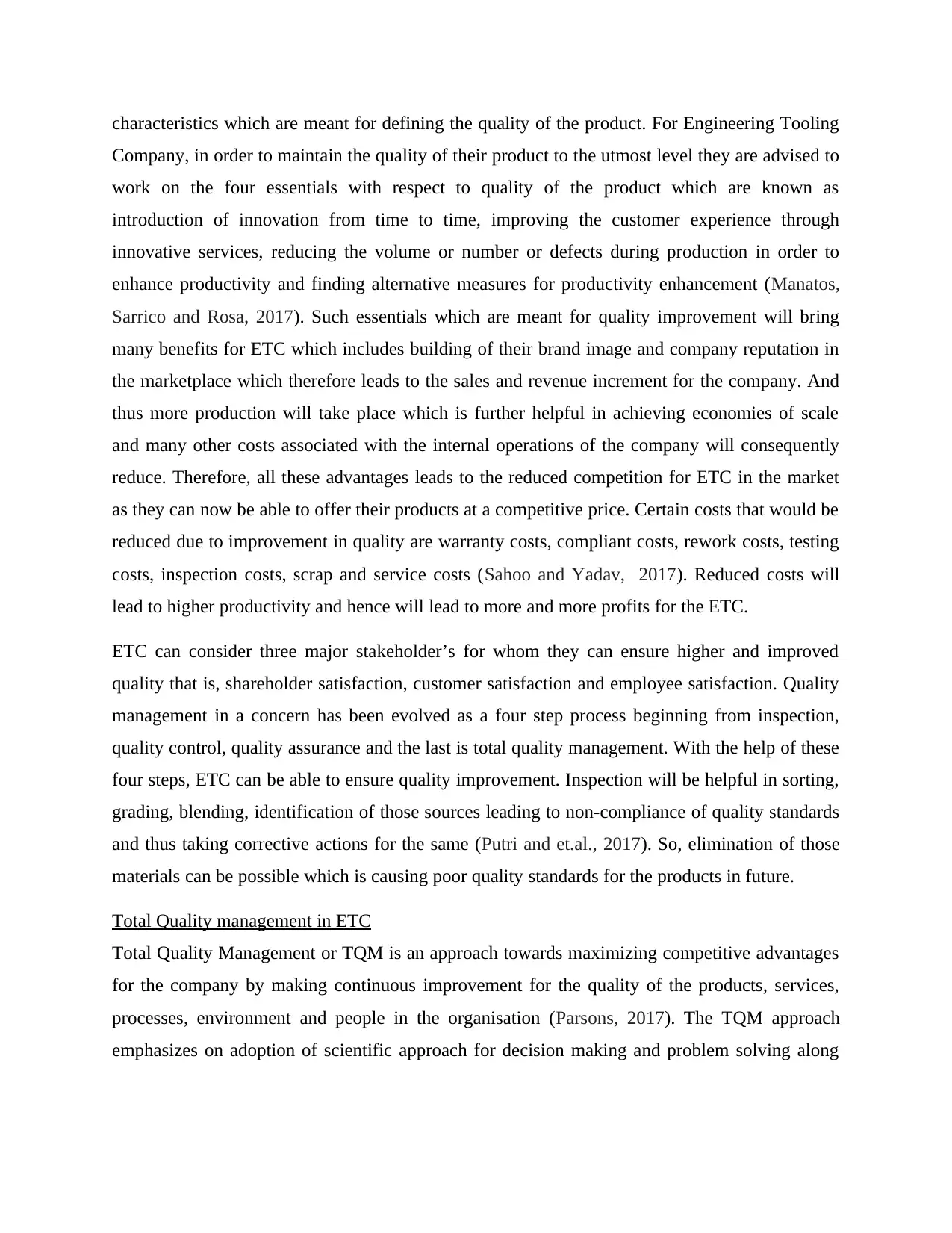
characteristics which are meant for defining the quality of the product. For Engineering Tooling
Company, in order to maintain the quality of their product to the utmost level they are advised to
work on the four essentials with respect to quality of the product which are known as
introduction of innovation from time to time, improving the customer experience through
innovative services, reducing the volume or number or defects during production in order to
enhance productivity and finding alternative measures for productivity enhancement (Manatos,
Sarrico and Rosa, 2017). Such essentials which are meant for quality improvement will bring
many benefits for ETC which includes building of their brand image and company reputation in
the marketplace which therefore leads to the sales and revenue increment for the company. And
thus more production will take place which is further helpful in achieving economies of scale
and many other costs associated with the internal operations of the company will consequently
reduce. Therefore, all these advantages leads to the reduced competition for ETC in the market
as they can now be able to offer their products at a competitive price. Certain costs that would be
reduced due to improvement in quality are warranty costs, compliant costs, rework costs, testing
costs, inspection costs, scrap and service costs (Sahoo and Yadav, 2017). Reduced costs will
lead to higher productivity and hence will lead to more and more profits for the ETC.
ETC can consider three major stakeholder’s for whom they can ensure higher and improved
quality that is, shareholder satisfaction, customer satisfaction and employee satisfaction. Quality
management in a concern has been evolved as a four step process beginning from inspection,
quality control, quality assurance and the last is total quality management. With the help of these
four steps, ETC can be able to ensure quality improvement. Inspection will be helpful in sorting,
grading, blending, identification of those sources leading to non-compliance of quality standards
and thus taking corrective actions for the same (Putri and et.al., 2017). So, elimination of those
materials can be possible which is causing poor quality standards for the products in future.
Total Quality management in ETC
Total Quality Management or TQM is an approach towards maximizing competitive advantages
for the company by making continuous improvement for the quality of the products, services,
processes, environment and people in the organisation (Parsons, 2017). The TQM approach
emphasizes on adoption of scientific approach for decision making and problem solving along
Company, in order to maintain the quality of their product to the utmost level they are advised to
work on the four essentials with respect to quality of the product which are known as
introduction of innovation from time to time, improving the customer experience through
innovative services, reducing the volume or number or defects during production in order to
enhance productivity and finding alternative measures for productivity enhancement (Manatos,
Sarrico and Rosa, 2017). Such essentials which are meant for quality improvement will bring
many benefits for ETC which includes building of their brand image and company reputation in
the marketplace which therefore leads to the sales and revenue increment for the company. And
thus more production will take place which is further helpful in achieving economies of scale
and many other costs associated with the internal operations of the company will consequently
reduce. Therefore, all these advantages leads to the reduced competition for ETC in the market
as they can now be able to offer their products at a competitive price. Certain costs that would be
reduced due to improvement in quality are warranty costs, compliant costs, rework costs, testing
costs, inspection costs, scrap and service costs (Sahoo and Yadav, 2017). Reduced costs will
lead to higher productivity and hence will lead to more and more profits for the ETC.
ETC can consider three major stakeholder’s for whom they can ensure higher and improved
quality that is, shareholder satisfaction, customer satisfaction and employee satisfaction. Quality
management in a concern has been evolved as a four step process beginning from inspection,
quality control, quality assurance and the last is total quality management. With the help of these
four steps, ETC can be able to ensure quality improvement. Inspection will be helpful in sorting,
grading, blending, identification of those sources leading to non-compliance of quality standards
and thus taking corrective actions for the same (Putri and et.al., 2017). So, elimination of those
materials can be possible which is causing poor quality standards for the products in future.
Total Quality management in ETC
Total Quality Management or TQM is an approach towards maximizing competitive advantages
for the company by making continuous improvement for the quality of the products, services,
processes, environment and people in the organisation (Parsons, 2017). The TQM approach
emphasizes on adoption of scientific approach for decision making and problem solving along
Paraphrase This Document
Need a fresh take? Get an instant paraphrase of this document with our AI Paraphraser
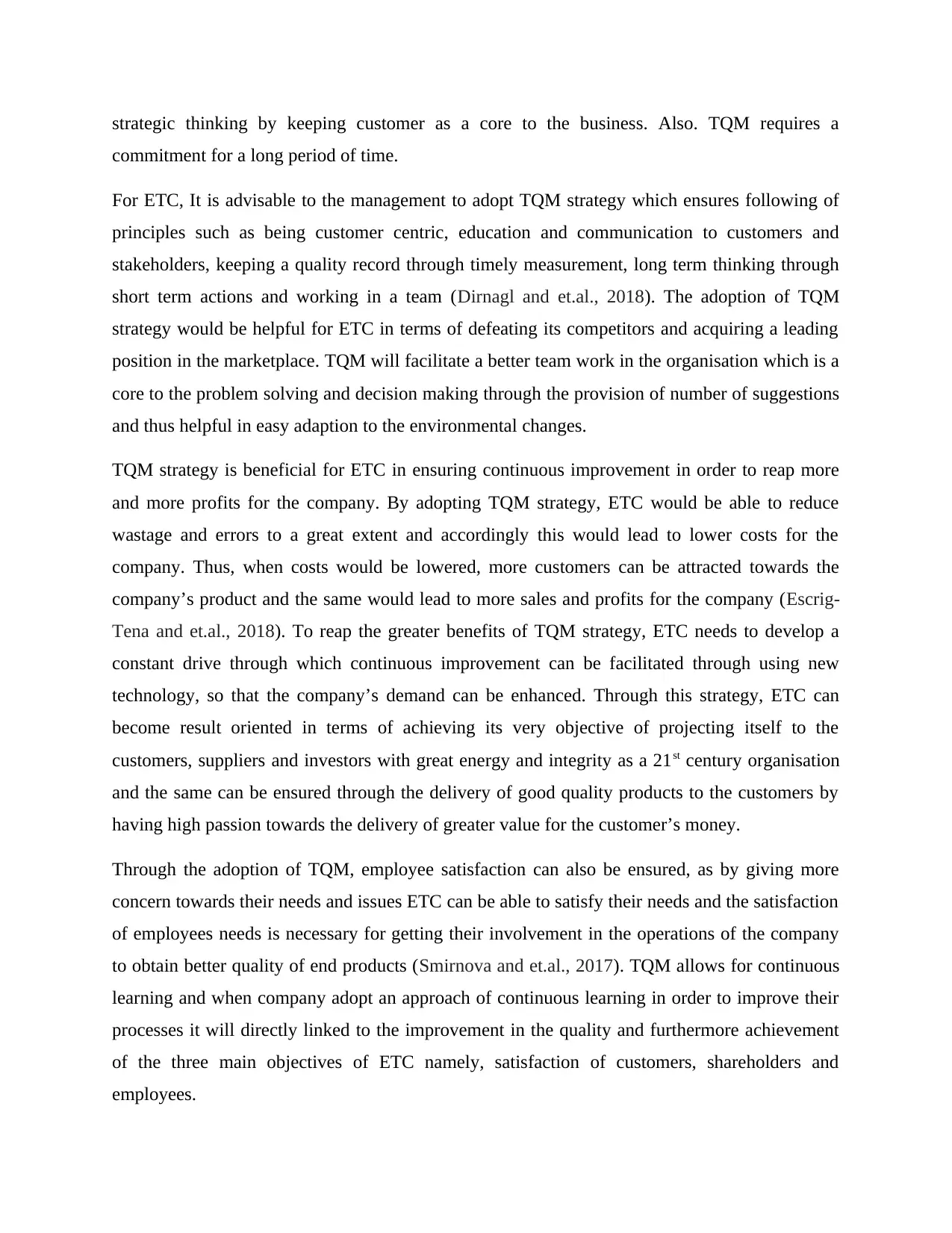
strategic thinking by keeping customer as a core to the business. Also. TQM requires a
commitment for a long period of time.
For ETC, It is advisable to the management to adopt TQM strategy which ensures following of
principles such as being customer centric, education and communication to customers and
stakeholders, keeping a quality record through timely measurement, long term thinking through
short term actions and working in a team (Dirnagl and et.al., 2018). The adoption of TQM
strategy would be helpful for ETC in terms of defeating its competitors and acquiring a leading
position in the marketplace. TQM will facilitate a better team work in the organisation which is a
core to the problem solving and decision making through the provision of number of suggestions
and thus helpful in easy adaption to the environmental changes.
TQM strategy is beneficial for ETC in ensuring continuous improvement in order to reap more
and more profits for the company. By adopting TQM strategy, ETC would be able to reduce
wastage and errors to a great extent and accordingly this would lead to lower costs for the
company. Thus, when costs would be lowered, more customers can be attracted towards the
company’s product and the same would lead to more sales and profits for the company (Escrig-
Tena and et.al., 2018). To reap the greater benefits of TQM strategy, ETC needs to develop a
constant drive through which continuous improvement can be facilitated through using new
technology, so that the company’s demand can be enhanced. Through this strategy, ETC can
become result oriented in terms of achieving its very objective of projecting itself to the
customers, suppliers and investors with great energy and integrity as a 21st century organisation
and the same can be ensured through the delivery of good quality products to the customers by
having high passion towards the delivery of greater value for the customer’s money.
Through the adoption of TQM, employee satisfaction can also be ensured, as by giving more
concern towards their needs and issues ETC can be able to satisfy their needs and the satisfaction
of employees needs is necessary for getting their involvement in the operations of the company
to obtain better quality of end products (Smirnova and et.al., 2017). TQM allows for continuous
learning and when company adopt an approach of continuous learning in order to improve their
processes it will directly linked to the improvement in the quality and furthermore achievement
of the three main objectives of ETC namely, satisfaction of customers, shareholders and
employees.
commitment for a long period of time.
For ETC, It is advisable to the management to adopt TQM strategy which ensures following of
principles such as being customer centric, education and communication to customers and
stakeholders, keeping a quality record through timely measurement, long term thinking through
short term actions and working in a team (Dirnagl and et.al., 2018). The adoption of TQM
strategy would be helpful for ETC in terms of defeating its competitors and acquiring a leading
position in the marketplace. TQM will facilitate a better team work in the organisation which is a
core to the problem solving and decision making through the provision of number of suggestions
and thus helpful in easy adaption to the environmental changes.
TQM strategy is beneficial for ETC in ensuring continuous improvement in order to reap more
and more profits for the company. By adopting TQM strategy, ETC would be able to reduce
wastage and errors to a great extent and accordingly this would lead to lower costs for the
company. Thus, when costs would be lowered, more customers can be attracted towards the
company’s product and the same would lead to more sales and profits for the company (Escrig-
Tena and et.al., 2018). To reap the greater benefits of TQM strategy, ETC needs to develop a
constant drive through which continuous improvement can be facilitated through using new
technology, so that the company’s demand can be enhanced. Through this strategy, ETC can
become result oriented in terms of achieving its very objective of projecting itself to the
customers, suppliers and investors with great energy and integrity as a 21st century organisation
and the same can be ensured through the delivery of good quality products to the customers by
having high passion towards the delivery of greater value for the customer’s money.
Through the adoption of TQM, employee satisfaction can also be ensured, as by giving more
concern towards their needs and issues ETC can be able to satisfy their needs and the satisfaction
of employees needs is necessary for getting their involvement in the operations of the company
to obtain better quality of end products (Smirnova and et.al., 2017). TQM allows for continuous
learning and when company adopt an approach of continuous learning in order to improve their
processes it will directly linked to the improvement in the quality and furthermore achievement
of the three main objectives of ETC namely, satisfaction of customers, shareholders and
employees.
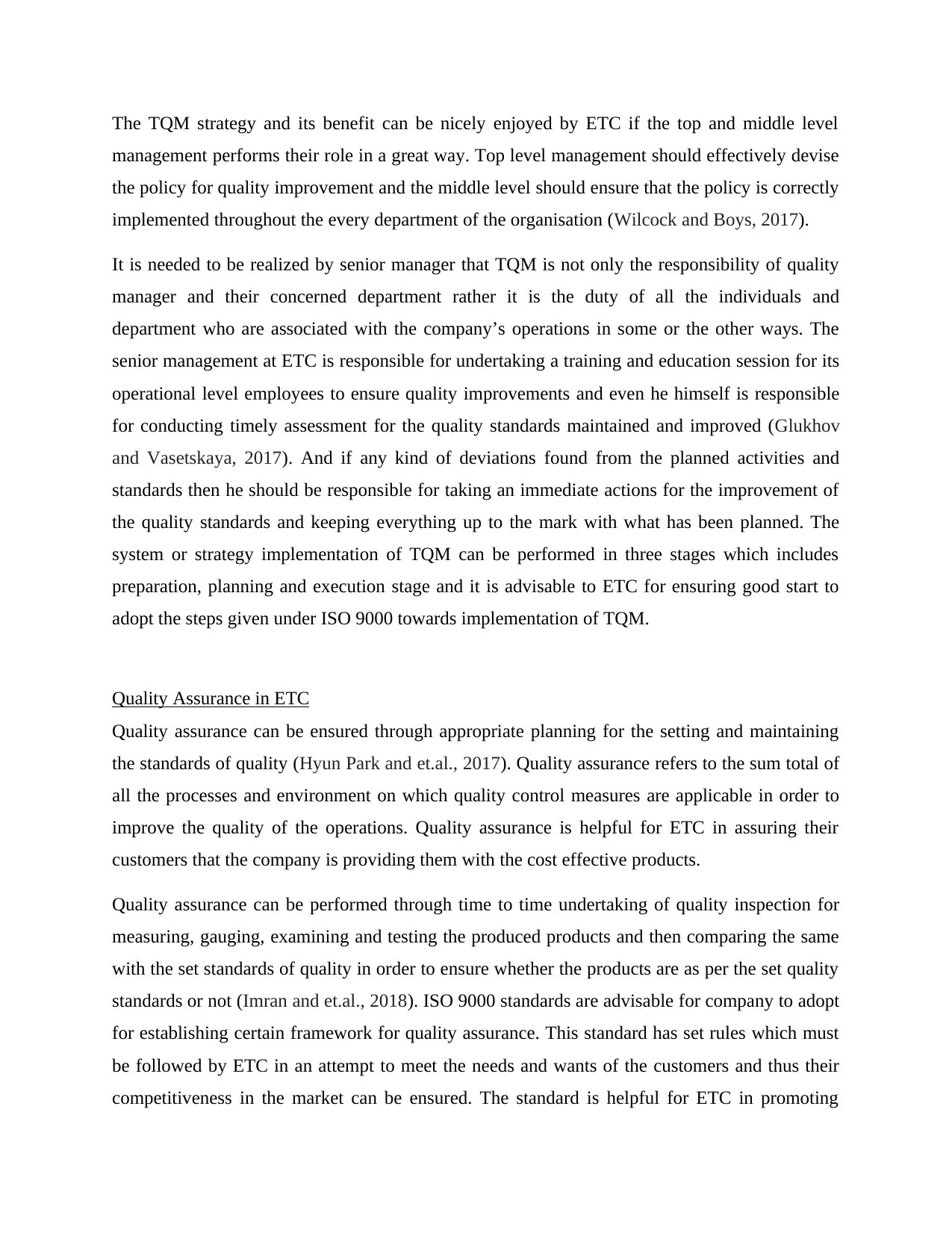
The TQM strategy and its benefit can be nicely enjoyed by ETC if the top and middle level
management performs their role in a great way. Top level management should effectively devise
the policy for quality improvement and the middle level should ensure that the policy is correctly
implemented throughout the every department of the organisation (Wilcock and Boys, 2017).
It is needed to be realized by senior manager that TQM is not only the responsibility of quality
manager and their concerned department rather it is the duty of all the individuals and
department who are associated with the company’s operations in some or the other ways. The
senior management at ETC is responsible for undertaking a training and education session for its
operational level employees to ensure quality improvements and even he himself is responsible
for conducting timely assessment for the quality standards maintained and improved (Glukhov
and Vasetskaya, 2017). And if any kind of deviations found from the planned activities and
standards then he should be responsible for taking an immediate actions for the improvement of
the quality standards and keeping everything up to the mark with what has been planned. The
system or strategy implementation of TQM can be performed in three stages which includes
preparation, planning and execution stage and it is advisable to ETC for ensuring good start to
adopt the steps given under ISO 9000 towards implementation of TQM.
Quality Assurance in ETC
Quality assurance can be ensured through appropriate planning for the setting and maintaining
the standards of quality (Hyun Park and et.al., 2017). Quality assurance refers to the sum total of
all the processes and environment on which quality control measures are applicable in order to
improve the quality of the operations. Quality assurance is helpful for ETC in assuring their
customers that the company is providing them with the cost effective products.
Quality assurance can be performed through time to time undertaking of quality inspection for
measuring, gauging, examining and testing the produced products and then comparing the same
with the set standards of quality in order to ensure whether the products are as per the set quality
standards or not (Imran and et.al., 2018). ISO 9000 standards are advisable for company to adopt
for establishing certain framework for quality assurance. This standard has set rules which must
be followed by ETC in an attempt to meet the needs and wants of the customers and thus their
competitiveness in the market can be ensured. The standard is helpful for ETC in promoting
management performs their role in a great way. Top level management should effectively devise
the policy for quality improvement and the middle level should ensure that the policy is correctly
implemented throughout the every department of the organisation (Wilcock and Boys, 2017).
It is needed to be realized by senior manager that TQM is not only the responsibility of quality
manager and their concerned department rather it is the duty of all the individuals and
department who are associated with the company’s operations in some or the other ways. The
senior management at ETC is responsible for undertaking a training and education session for its
operational level employees to ensure quality improvements and even he himself is responsible
for conducting timely assessment for the quality standards maintained and improved (Glukhov
and Vasetskaya, 2017). And if any kind of deviations found from the planned activities and
standards then he should be responsible for taking an immediate actions for the improvement of
the quality standards and keeping everything up to the mark with what has been planned. The
system or strategy implementation of TQM can be performed in three stages which includes
preparation, planning and execution stage and it is advisable to ETC for ensuring good start to
adopt the steps given under ISO 9000 towards implementation of TQM.
Quality Assurance in ETC
Quality assurance can be ensured through appropriate planning for the setting and maintaining
the standards of quality (Hyun Park and et.al., 2017). Quality assurance refers to the sum total of
all the processes and environment on which quality control measures are applicable in order to
improve the quality of the operations. Quality assurance is helpful for ETC in assuring their
customers that the company is providing them with the cost effective products.
Quality assurance can be performed through time to time undertaking of quality inspection for
measuring, gauging, examining and testing the produced products and then comparing the same
with the set standards of quality in order to ensure whether the products are as per the set quality
standards or not (Imran and et.al., 2018). ISO 9000 standards are advisable for company to adopt
for establishing certain framework for quality assurance. This standard has set rules which must
be followed by ETC in an attempt to meet the needs and wants of the customers and thus their
competitiveness in the market can be ensured. The standard is helpful for ETC in promoting
⊘ This is a preview!⊘
Do you want full access?
Subscribe today to unlock all pages.

Trusted by 1+ million students worldwide
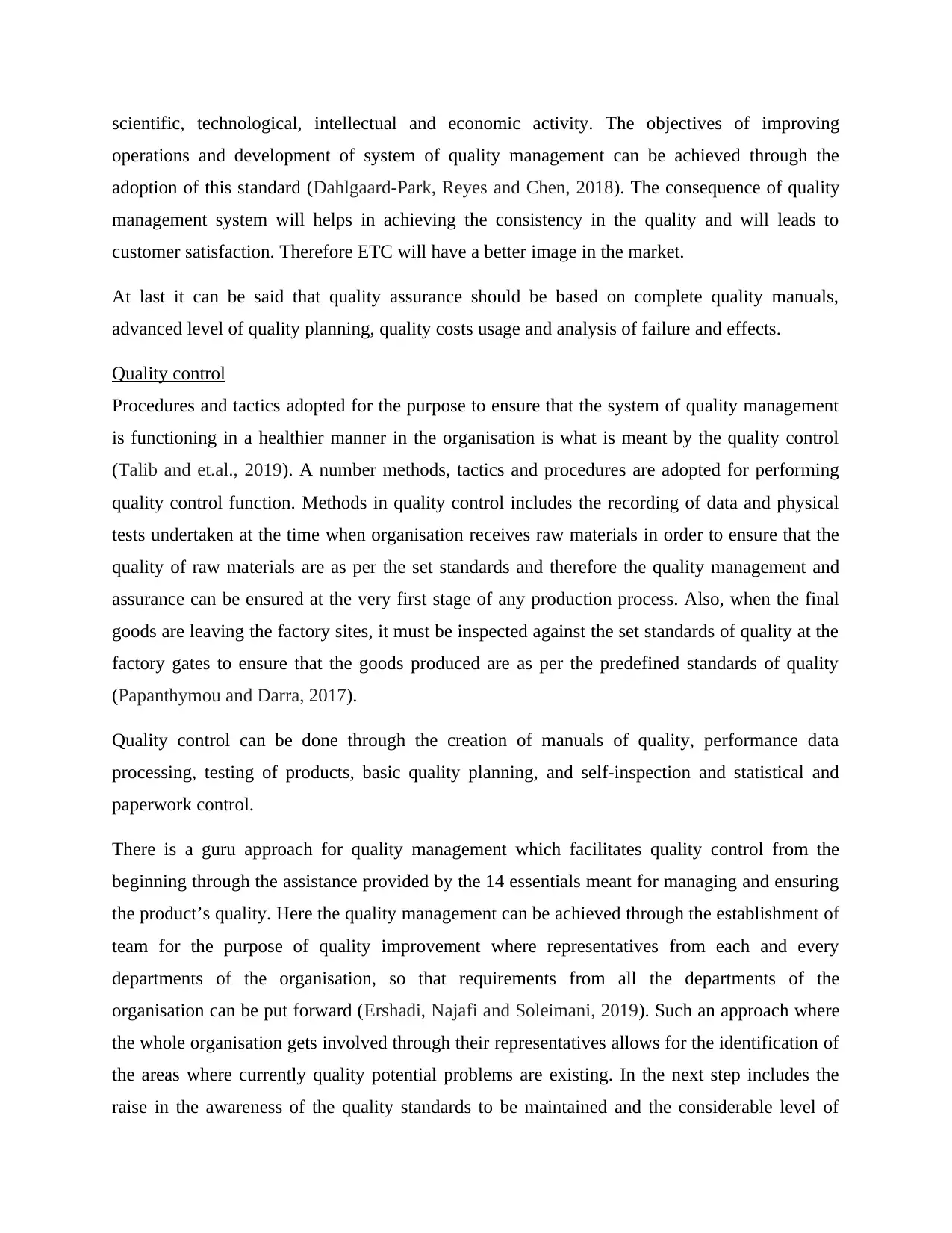
scientific, technological, intellectual and economic activity. The objectives of improving
operations and development of system of quality management can be achieved through the
adoption of this standard (Dahlgaard-Park, Reyes and Chen, 2018). The consequence of quality
management system will helps in achieving the consistency in the quality and will leads to
customer satisfaction. Therefore ETC will have a better image in the market.
At last it can be said that quality assurance should be based on complete quality manuals,
advanced level of quality planning, quality costs usage and analysis of failure and effects.
Quality control
Procedures and tactics adopted for the purpose to ensure that the system of quality management
is functioning in a healthier manner in the organisation is what is meant by the quality control
(Talib and et.al., 2019). A number methods, tactics and procedures are adopted for performing
quality control function. Methods in quality control includes the recording of data and physical
tests undertaken at the time when organisation receives raw materials in order to ensure that the
quality of raw materials are as per the set standards and therefore the quality management and
assurance can be ensured at the very first stage of any production process. Also, when the final
goods are leaving the factory sites, it must be inspected against the set standards of quality at the
factory gates to ensure that the goods produced are as per the predefined standards of quality
(Papanthymou and Darra, 2017).
Quality control can be done through the creation of manuals of quality, performance data
processing, testing of products, basic quality planning, and self-inspection and statistical and
paperwork control.
There is a guru approach for quality management which facilitates quality control from the
beginning through the assistance provided by the 14 essentials meant for managing and ensuring
the product’s quality. Here the quality management can be achieved through the establishment of
team for the purpose of quality improvement where representatives from each and every
departments of the organisation, so that requirements from all the departments of the
organisation can be put forward (Ershadi, Najafi and Soleimani, 2019). Such an approach where
the whole organisation gets involved through their representatives allows for the identification of
the areas where currently quality potential problems are existing. In the next step includes the
raise in the awareness of the quality standards to be maintained and the considerable level of
operations and development of system of quality management can be achieved through the
adoption of this standard (Dahlgaard-Park, Reyes and Chen, 2018). The consequence of quality
management system will helps in achieving the consistency in the quality and will leads to
customer satisfaction. Therefore ETC will have a better image in the market.
At last it can be said that quality assurance should be based on complete quality manuals,
advanced level of quality planning, quality costs usage and analysis of failure and effects.
Quality control
Procedures and tactics adopted for the purpose to ensure that the system of quality management
is functioning in a healthier manner in the organisation is what is meant by the quality control
(Talib and et.al., 2019). A number methods, tactics and procedures are adopted for performing
quality control function. Methods in quality control includes the recording of data and physical
tests undertaken at the time when organisation receives raw materials in order to ensure that the
quality of raw materials are as per the set standards and therefore the quality management and
assurance can be ensured at the very first stage of any production process. Also, when the final
goods are leaving the factory sites, it must be inspected against the set standards of quality at the
factory gates to ensure that the goods produced are as per the predefined standards of quality
(Papanthymou and Darra, 2017).
Quality control can be done through the creation of manuals of quality, performance data
processing, testing of products, basic quality planning, and self-inspection and statistical and
paperwork control.
There is a guru approach for quality management which facilitates quality control from the
beginning through the assistance provided by the 14 essentials meant for managing and ensuring
the product’s quality. Here the quality management can be achieved through the establishment of
team for the purpose of quality improvement where representatives from each and every
departments of the organisation, so that requirements from all the departments of the
organisation can be put forward (Ershadi, Najafi and Soleimani, 2019). Such an approach where
the whole organisation gets involved through their representatives allows for the identification of
the areas where currently quality potential problems are existing. In the next step includes the
raise in the awareness of the quality standards to be maintained and the considerable level of
Paraphrase This Document
Need a fresh take? Get an instant paraphrase of this document with our AI Paraphraser
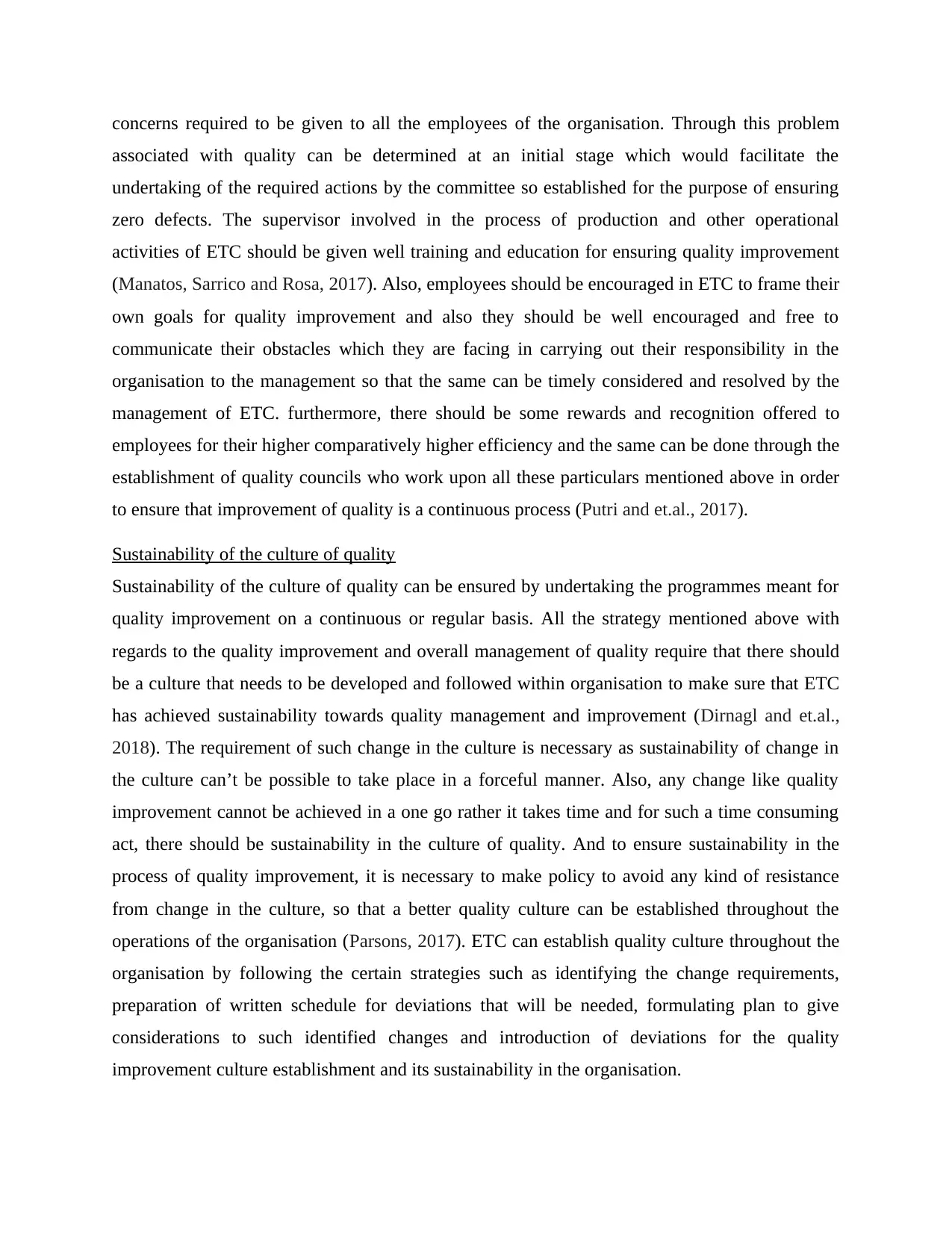
concerns required to be given to all the employees of the organisation. Through this problem
associated with quality can be determined at an initial stage which would facilitate the
undertaking of the required actions by the committee so established for the purpose of ensuring
zero defects. The supervisor involved in the process of production and other operational
activities of ETC should be given well training and education for ensuring quality improvement
(Manatos, Sarrico and Rosa, 2017). Also, employees should be encouraged in ETC to frame their
own goals for quality improvement and also they should be well encouraged and free to
communicate their obstacles which they are facing in carrying out their responsibility in the
organisation to the management so that the same can be timely considered and resolved by the
management of ETC. furthermore, there should be some rewards and recognition offered to
employees for their higher comparatively higher efficiency and the same can be done through the
establishment of quality councils who work upon all these particulars mentioned above in order
to ensure that improvement of quality is a continuous process (Putri and et.al., 2017).
Sustainability of the culture of quality
Sustainability of the culture of quality can be ensured by undertaking the programmes meant for
quality improvement on a continuous or regular basis. All the strategy mentioned above with
regards to the quality improvement and overall management of quality require that there should
be a culture that needs to be developed and followed within organisation to make sure that ETC
has achieved sustainability towards quality management and improvement (Dirnagl and et.al.,
2018). The requirement of such change in the culture is necessary as sustainability of change in
the culture can’t be possible to take place in a forceful manner. Also, any change like quality
improvement cannot be achieved in a one go rather it takes time and for such a time consuming
act, there should be sustainability in the culture of quality. And to ensure sustainability in the
process of quality improvement, it is necessary to make policy to avoid any kind of resistance
from change in the culture, so that a better quality culture can be established throughout the
operations of the organisation (Parsons, 2017). ETC can establish quality culture throughout the
organisation by following the certain strategies such as identifying the change requirements,
preparation of written schedule for deviations that will be needed, formulating plan to give
considerations to such identified changes and introduction of deviations for the quality
improvement culture establishment and its sustainability in the organisation.
associated with quality can be determined at an initial stage which would facilitate the
undertaking of the required actions by the committee so established for the purpose of ensuring
zero defects. The supervisor involved in the process of production and other operational
activities of ETC should be given well training and education for ensuring quality improvement
(Manatos, Sarrico and Rosa, 2017). Also, employees should be encouraged in ETC to frame their
own goals for quality improvement and also they should be well encouraged and free to
communicate their obstacles which they are facing in carrying out their responsibility in the
organisation to the management so that the same can be timely considered and resolved by the
management of ETC. furthermore, there should be some rewards and recognition offered to
employees for their higher comparatively higher efficiency and the same can be done through the
establishment of quality councils who work upon all these particulars mentioned above in order
to ensure that improvement of quality is a continuous process (Putri and et.al., 2017).
Sustainability of the culture of quality
Sustainability of the culture of quality can be ensured by undertaking the programmes meant for
quality improvement on a continuous or regular basis. All the strategy mentioned above with
regards to the quality improvement and overall management of quality require that there should
be a culture that needs to be developed and followed within organisation to make sure that ETC
has achieved sustainability towards quality management and improvement (Dirnagl and et.al.,
2018). The requirement of such change in the culture is necessary as sustainability of change in
the culture can’t be possible to take place in a forceful manner. Also, any change like quality
improvement cannot be achieved in a one go rather it takes time and for such a time consuming
act, there should be sustainability in the culture of quality. And to ensure sustainability in the
process of quality improvement, it is necessary to make policy to avoid any kind of resistance
from change in the culture, so that a better quality culture can be established throughout the
operations of the organisation (Parsons, 2017). ETC can establish quality culture throughout the
organisation by following the certain strategies such as identifying the change requirements,
preparation of written schedule for deviations that will be needed, formulating plan to give
considerations to such identified changes and introduction of deviations for the quality
improvement culture establishment and its sustainability in the organisation.
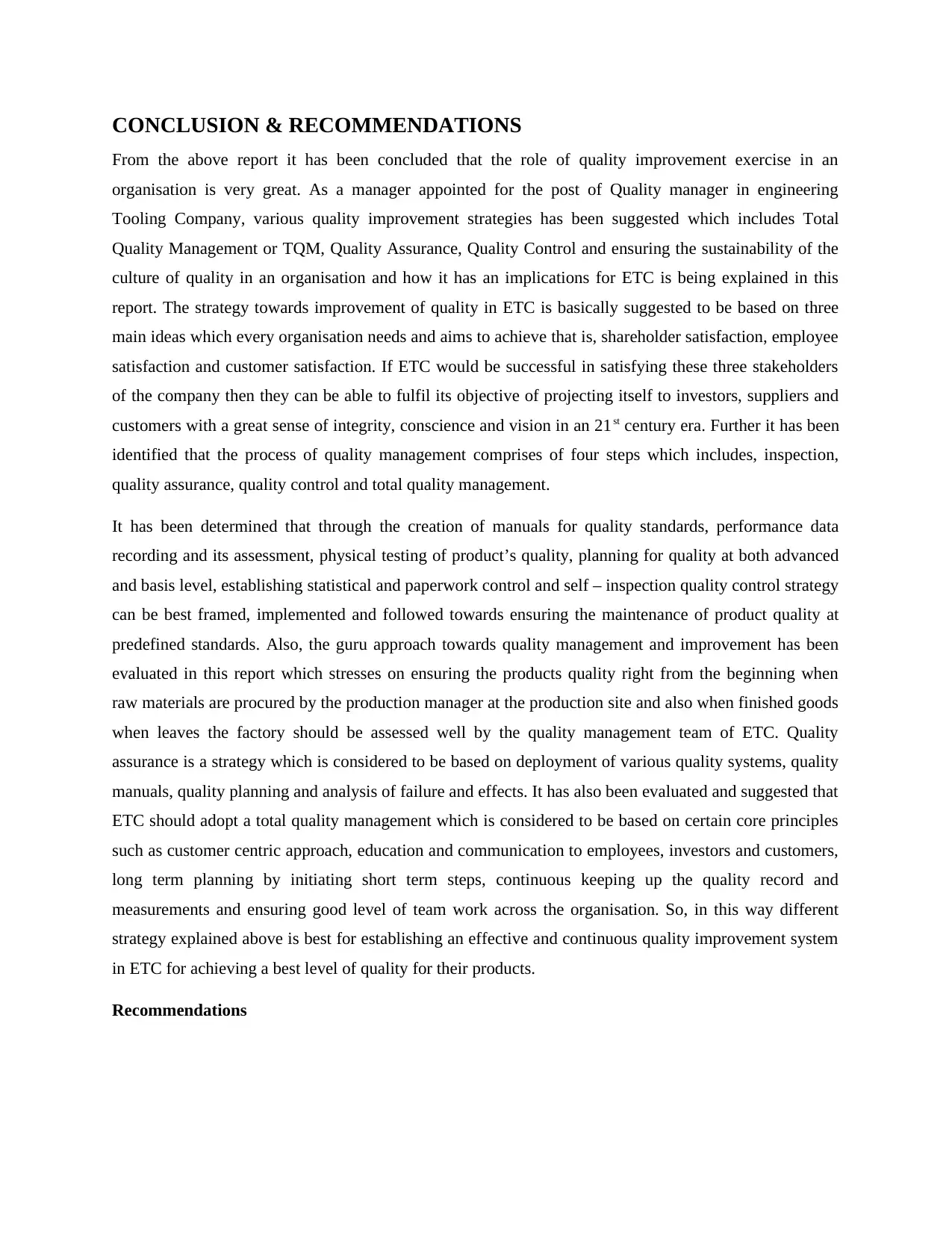
CONCLUSION & RECOMMENDATIONS
From the above report it has been concluded that the role of quality improvement exercise in an
organisation is very great. As a manager appointed for the post of Quality manager in engineering
Tooling Company, various quality improvement strategies has been suggested which includes Total
Quality Management or TQM, Quality Assurance, Quality Control and ensuring the sustainability of the
culture of quality in an organisation and how it has an implications for ETC is being explained in this
report. The strategy towards improvement of quality in ETC is basically suggested to be based on three
main ideas which every organisation needs and aims to achieve that is, shareholder satisfaction, employee
satisfaction and customer satisfaction. If ETC would be successful in satisfying these three stakeholders
of the company then they can be able to fulfil its objective of projecting itself to investors, suppliers and
customers with a great sense of integrity, conscience and vision in an 21st century era. Further it has been
identified that the process of quality management comprises of four steps which includes, inspection,
quality assurance, quality control and total quality management.
It has been determined that through the creation of manuals for quality standards, performance data
recording and its assessment, physical testing of product’s quality, planning for quality at both advanced
and basis level, establishing statistical and paperwork control and self – inspection quality control strategy
can be best framed, implemented and followed towards ensuring the maintenance of product quality at
predefined standards. Also, the guru approach towards quality management and improvement has been
evaluated in this report which stresses on ensuring the products quality right from the beginning when
raw materials are procured by the production manager at the production site and also when finished goods
when leaves the factory should be assessed well by the quality management team of ETC. Quality
assurance is a strategy which is considered to be based on deployment of various quality systems, quality
manuals, quality planning and analysis of failure and effects. It has also been evaluated and suggested that
ETC should adopt a total quality management which is considered to be based on certain core principles
such as customer centric approach, education and communication to employees, investors and customers,
long term planning by initiating short term steps, continuous keeping up the quality record and
measurements and ensuring good level of team work across the organisation. So, in this way different
strategy explained above is best for establishing an effective and continuous quality improvement system
in ETC for achieving a best level of quality for their products.
Recommendations
From the above report it has been concluded that the role of quality improvement exercise in an
organisation is very great. As a manager appointed for the post of Quality manager in engineering
Tooling Company, various quality improvement strategies has been suggested which includes Total
Quality Management or TQM, Quality Assurance, Quality Control and ensuring the sustainability of the
culture of quality in an organisation and how it has an implications for ETC is being explained in this
report. The strategy towards improvement of quality in ETC is basically suggested to be based on three
main ideas which every organisation needs and aims to achieve that is, shareholder satisfaction, employee
satisfaction and customer satisfaction. If ETC would be successful in satisfying these three stakeholders
of the company then they can be able to fulfil its objective of projecting itself to investors, suppliers and
customers with a great sense of integrity, conscience and vision in an 21st century era. Further it has been
identified that the process of quality management comprises of four steps which includes, inspection,
quality assurance, quality control and total quality management.
It has been determined that through the creation of manuals for quality standards, performance data
recording and its assessment, physical testing of product’s quality, planning for quality at both advanced
and basis level, establishing statistical and paperwork control and self – inspection quality control strategy
can be best framed, implemented and followed towards ensuring the maintenance of product quality at
predefined standards. Also, the guru approach towards quality management and improvement has been
evaluated in this report which stresses on ensuring the products quality right from the beginning when
raw materials are procured by the production manager at the production site and also when finished goods
when leaves the factory should be assessed well by the quality management team of ETC. Quality
assurance is a strategy which is considered to be based on deployment of various quality systems, quality
manuals, quality planning and analysis of failure and effects. It has also been evaluated and suggested that
ETC should adopt a total quality management which is considered to be based on certain core principles
such as customer centric approach, education and communication to employees, investors and customers,
long term planning by initiating short term steps, continuous keeping up the quality record and
measurements and ensuring good level of team work across the organisation. So, in this way different
strategy explained above is best for establishing an effective and continuous quality improvement system
in ETC for achieving a best level of quality for their products.
Recommendations
⊘ This is a preview!⊘
Do you want full access?
Subscribe today to unlock all pages.

Trusted by 1+ million students worldwide
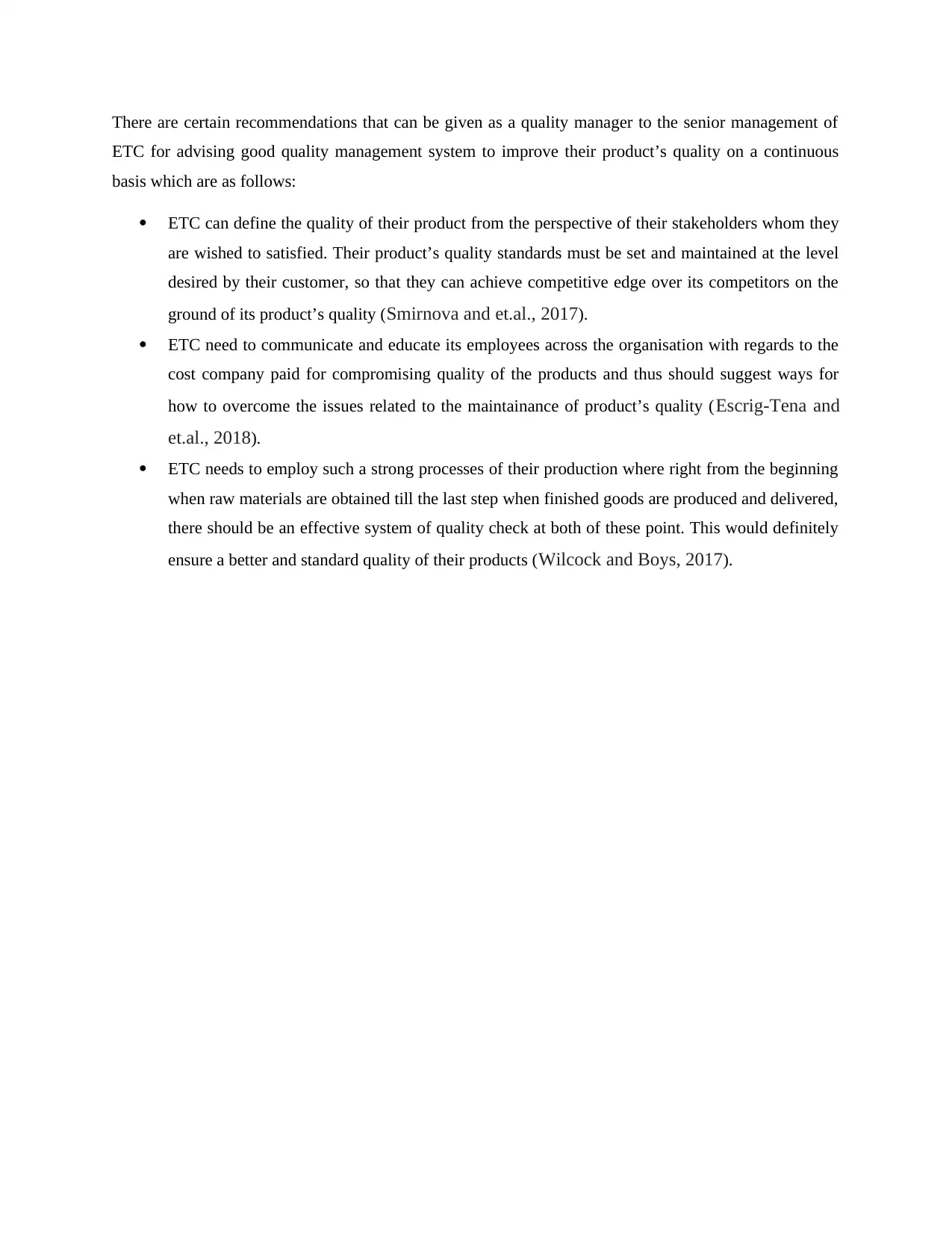
There are certain recommendations that can be given as a quality manager to the senior management of
ETC for advising good quality management system to improve their product’s quality on a continuous
basis which are as follows:
ETC can define the quality of their product from the perspective of their stakeholders whom they
are wished to satisfied. Their product’s quality standards must be set and maintained at the level
desired by their customer, so that they can achieve competitive edge over its competitors on the
ground of its product’s quality (Smirnova and et.al., 2017).
ETC need to communicate and educate its employees across the organisation with regards to the
cost company paid for compromising quality of the products and thus should suggest ways for
how to overcome the issues related to the maintainance of product’s quality (Escrig-Tena and
et.al., 2018).
ETC needs to employ such a strong processes of their production where right from the beginning
when raw materials are obtained till the last step when finished goods are produced and delivered,
there should be an effective system of quality check at both of these point. This would definitely
ensure a better and standard quality of their products (Wilcock and Boys, 2017).
ETC for advising good quality management system to improve their product’s quality on a continuous
basis which are as follows:
ETC can define the quality of their product from the perspective of their stakeholders whom they
are wished to satisfied. Their product’s quality standards must be set and maintained at the level
desired by their customer, so that they can achieve competitive edge over its competitors on the
ground of its product’s quality (Smirnova and et.al., 2017).
ETC need to communicate and educate its employees across the organisation with regards to the
cost company paid for compromising quality of the products and thus should suggest ways for
how to overcome the issues related to the maintainance of product’s quality (Escrig-Tena and
et.al., 2018).
ETC needs to employ such a strong processes of their production where right from the beginning
when raw materials are obtained till the last step when finished goods are produced and delivered,
there should be an effective system of quality check at both of these point. This would definitely
ensure a better and standard quality of their products (Wilcock and Boys, 2017).
Paraphrase This Document
Need a fresh take? Get an instant paraphrase of this document with our AI Paraphraser
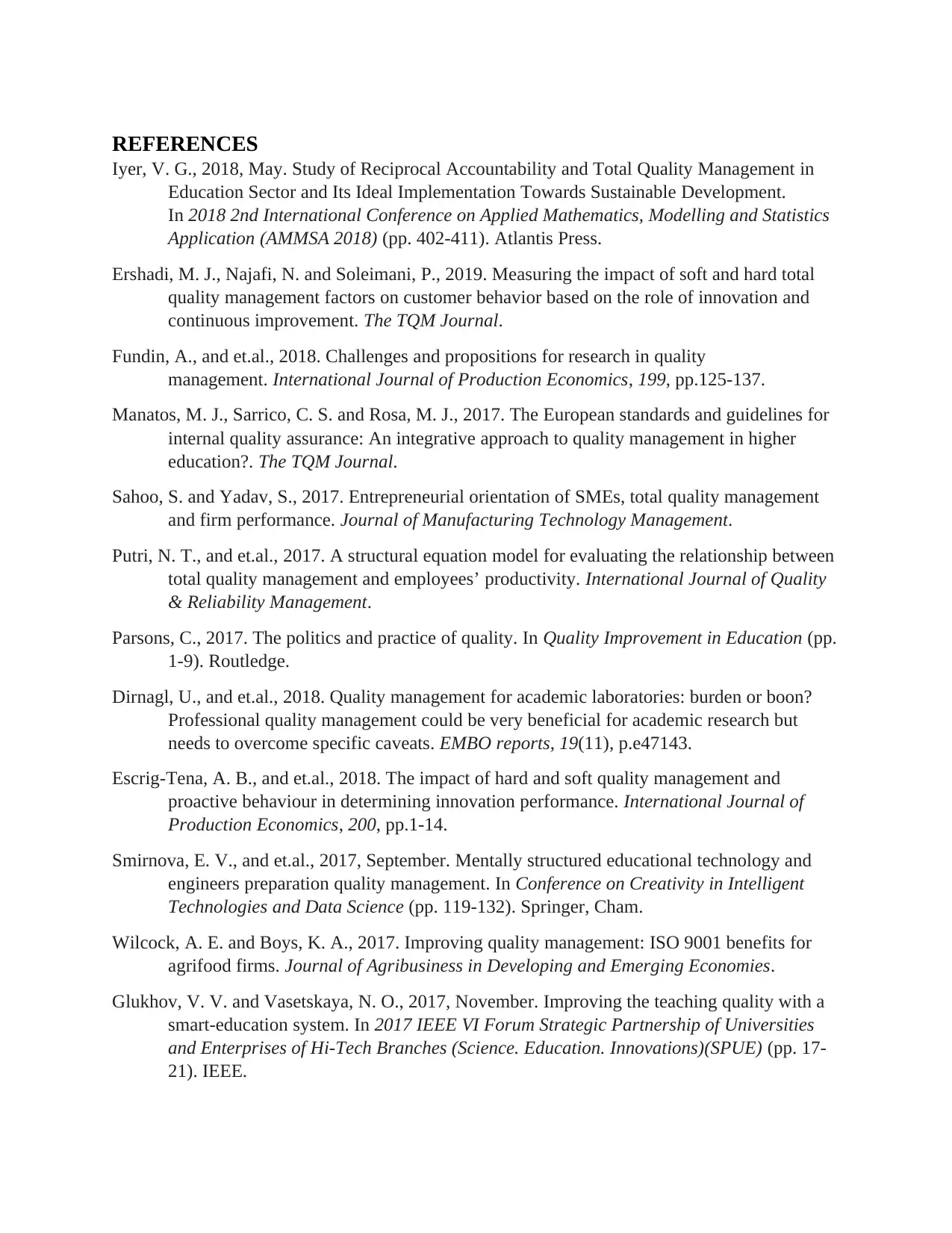
REFERENCES
Iyer, V. G., 2018, May. Study of Reciprocal Accountability and Total Quality Management in
Education Sector and Its Ideal Implementation Towards Sustainable Development.
In 2018 2nd International Conference on Applied Mathematics, Modelling and Statistics
Application (AMMSA 2018) (pp. 402-411). Atlantis Press.
Ershadi, M. J., Najafi, N. and Soleimani, P., 2019. Measuring the impact of soft and hard total
quality management factors on customer behavior based on the role of innovation and
continuous improvement. The TQM Journal.
Fundin, A., and et.al., 2018. Challenges and propositions for research in quality
management. International Journal of Production Economics, 199, pp.125-137.
Manatos, M. J., Sarrico, C. S. and Rosa, M. J., 2017. The European standards and guidelines for
internal quality assurance: An integrative approach to quality management in higher
education?. The TQM Journal.
Sahoo, S. and Yadav, S., 2017. Entrepreneurial orientation of SMEs, total quality management
and firm performance. Journal of Manufacturing Technology Management.
Putri, N. T., and et.al., 2017. A structural equation model for evaluating the relationship between
total quality management and employees’ productivity. International Journal of Quality
& Reliability Management.
Parsons, C., 2017. The politics and practice of quality. In Quality Improvement in Education (pp.
1-9). Routledge.
Dirnagl, U., and et.al., 2018. Quality management for academic laboratories: burden or boon?
Professional quality management could be very beneficial for academic research but
needs to overcome specific caveats. EMBO reports, 19(11), p.e47143.
Escrig-Tena, A. B., and et.al., 2018. The impact of hard and soft quality management and
proactive behaviour in determining innovation performance. International Journal of
Production Economics, 200, pp.1-14.
Smirnova, E. V., and et.al., 2017, September. Mentally structured educational technology and
engineers preparation quality management. In Conference on Creativity in Intelligent
Technologies and Data Science (pp. 119-132). Springer, Cham.
Wilcock, A. E. and Boys, K. A., 2017. Improving quality management: ISO 9001 benefits for
agrifood firms. Journal of Agribusiness in Developing and Emerging Economies.
Glukhov, V. V. and Vasetskaya, N. O., 2017, November. Improving the teaching quality with a
smart-education system. In 2017 IEEE VI Forum Strategic Partnership of Universities
and Enterprises of Hi-Tech Branches (Science. Education. Innovations)(SPUE) (pp. 17-
21). IEEE.
Iyer, V. G., 2018, May. Study of Reciprocal Accountability and Total Quality Management in
Education Sector and Its Ideal Implementation Towards Sustainable Development.
In 2018 2nd International Conference on Applied Mathematics, Modelling and Statistics
Application (AMMSA 2018) (pp. 402-411). Atlantis Press.
Ershadi, M. J., Najafi, N. and Soleimani, P., 2019. Measuring the impact of soft and hard total
quality management factors on customer behavior based on the role of innovation and
continuous improvement. The TQM Journal.
Fundin, A., and et.al., 2018. Challenges and propositions for research in quality
management. International Journal of Production Economics, 199, pp.125-137.
Manatos, M. J., Sarrico, C. S. and Rosa, M. J., 2017. The European standards and guidelines for
internal quality assurance: An integrative approach to quality management in higher
education?. The TQM Journal.
Sahoo, S. and Yadav, S., 2017. Entrepreneurial orientation of SMEs, total quality management
and firm performance. Journal of Manufacturing Technology Management.
Putri, N. T., and et.al., 2017. A structural equation model for evaluating the relationship between
total quality management and employees’ productivity. International Journal of Quality
& Reliability Management.
Parsons, C., 2017. The politics and practice of quality. In Quality Improvement in Education (pp.
1-9). Routledge.
Dirnagl, U., and et.al., 2018. Quality management for academic laboratories: burden or boon?
Professional quality management could be very beneficial for academic research but
needs to overcome specific caveats. EMBO reports, 19(11), p.e47143.
Escrig-Tena, A. B., and et.al., 2018. The impact of hard and soft quality management and
proactive behaviour in determining innovation performance. International Journal of
Production Economics, 200, pp.1-14.
Smirnova, E. V., and et.al., 2017, September. Mentally structured educational technology and
engineers preparation quality management. In Conference on Creativity in Intelligent
Technologies and Data Science (pp. 119-132). Springer, Cham.
Wilcock, A. E. and Boys, K. A., 2017. Improving quality management: ISO 9001 benefits for
agrifood firms. Journal of Agribusiness in Developing and Emerging Economies.
Glukhov, V. V. and Vasetskaya, N. O., 2017, November. Improving the teaching quality with a
smart-education system. In 2017 IEEE VI Forum Strategic Partnership of Universities
and Enterprises of Hi-Tech Branches (Science. Education. Innovations)(SPUE) (pp. 17-
21). IEEE.
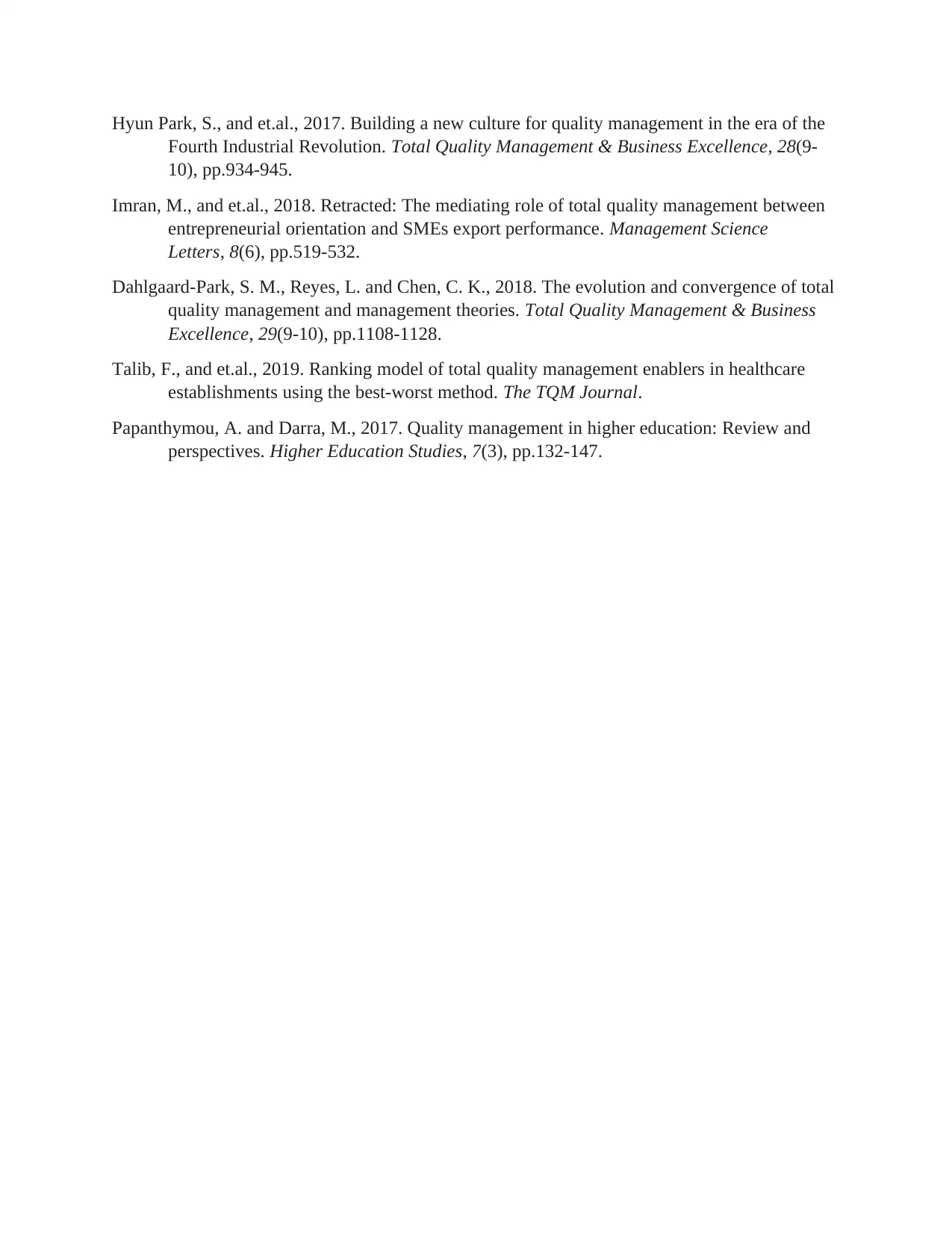
Hyun Park, S., and et.al., 2017. Building a new culture for quality management in the era of the
Fourth Industrial Revolution. Total Quality Management & Business Excellence, 28(9-
10), pp.934-945.
Imran, M., and et.al., 2018. Retracted: The mediating role of total quality management between
entrepreneurial orientation and SMEs export performance. Management Science
Letters, 8(6), pp.519-532.
Dahlgaard-Park, S. M., Reyes, L. and Chen, C. K., 2018. The evolution and convergence of total
quality management and management theories. Total Quality Management & Business
Excellence, 29(9-10), pp.1108-1128.
Talib, F., and et.al., 2019. Ranking model of total quality management enablers in healthcare
establishments using the best-worst method. The TQM Journal.
Papanthymou, A. and Darra, M., 2017. Quality management in higher education: Review and
perspectives. Higher Education Studies, 7(3), pp.132-147.
Fourth Industrial Revolution. Total Quality Management & Business Excellence, 28(9-
10), pp.934-945.
Imran, M., and et.al., 2018. Retracted: The mediating role of total quality management between
entrepreneurial orientation and SMEs export performance. Management Science
Letters, 8(6), pp.519-532.
Dahlgaard-Park, S. M., Reyes, L. and Chen, C. K., 2018. The evolution and convergence of total
quality management and management theories. Total Quality Management & Business
Excellence, 29(9-10), pp.1108-1128.
Talib, F., and et.al., 2019. Ranking model of total quality management enablers in healthcare
establishments using the best-worst method. The TQM Journal.
Papanthymou, A. and Darra, M., 2017. Quality management in higher education: Review and
perspectives. Higher Education Studies, 7(3), pp.132-147.
⊘ This is a preview!⊘
Do you want full access?
Subscribe today to unlock all pages.

Trusted by 1+ million students worldwide
1 out of 12
Related Documents
Your All-in-One AI-Powered Toolkit for Academic Success.
+13062052269
info@desklib.com
Available 24*7 on WhatsApp / Email
![[object Object]](/_next/static/media/star-bottom.7253800d.svg)
Unlock your academic potential
Copyright © 2020–2025 A2Z Services. All Rights Reserved. Developed and managed by ZUCOL.





